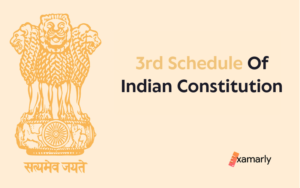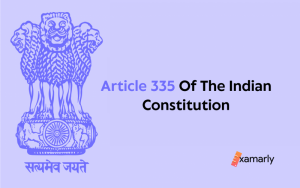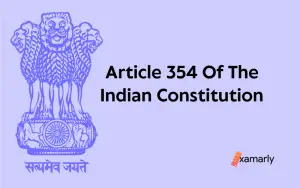The Indian Constitution is a living document that has evolved with the country over the years. It contains provisions that address the diverse needs of the nation and its citizens. However, as the country grows and faces new challenges, there may be a need to modify certain provisions of the Constitution to better reflect the changing circumstances. This is where Article 368 of the Indian Constitution comes in. This article outlines the procedure for amending the Constitution and grants Parliament the power to alter any provisions of the Constitution through the process of addition, modification, or repeal.
In this blog, we will delve into the provisions of Article 368 of the Indian Constitution and explore its significance in the process of amending the Constitution of India.
What Is Article 368 Of The Indian Constitution
Provisions of Article 368 are as follows:
- Regardless of any other provisions in the Constitution, Parliament has the authority to alter any provision of the Constitution through the process of addition, modification, or repeal, as part of its constituent power, as long as it follows the procedures outlined in this Article.
- An amendment to the Constitution can only be proposed by introducing a bill in either the Lok Sabha (the lower house of Parliament) or the Rajya Sabha (the upper house of Parliament). For the amendment to be passed, it must receive a majority of the total membership of each house, as well as a two-thirds majority of the members present and voting in each house. Once the bill has been passed by both houses, it is presented to the President of India for their assent. Upon receiving the President’s assent, the Constitution is amended in accordance with the provisions of the bill:
Providing, however, that in the event that such an amendment intends to make any modifications in—
(a) article 54, article 55, article 73, article 162, article 241, or article 279A; or
(b) Chapter IV of Part V, Chapter V of Part VI, or Chapter I of Part XI; or
(c) any of the Lists specified in the Seventh Schedule; or
(d) the representation of States in Parliament; or
(e) the provisions of this article,
an amendment to the Constitution must also be ratified by at least half of the state legislative assemblies in India before the bill making the provisions for such amendment can be presented to the President for their assent. This involves the passage of resolutions by these state legislative assemblies supporting the amendment. - Any alteration made in accordance with this article is exempt from the provisions of Article 13.
- No modification to this Constitution (including the provisions of Part III) made or ostensibly made under this article, whether before or after the effective date of section 55 of the Constitution (Forty-second Amendment) Act of 1976, shall be challenged in any court on any grounds.
- For the avoidance of doubt, it is expressly proclaimed that the constituent power of Parliament to alter this Constitution by way of addition, variation, or repeal should not be in any manner restricted.
Note
- Clause 3 was inserted by the 24th amendment of the Indian Constitution.
- Clause 4 was inserted by the 42nd amendment of the Indian Constitution.
Relatable Articles:
Why It Becomes Necessary To Amend Certain Provisions Of The Constitution Of India
There may be several reasons why it becomes necessary to amend certain provisions of the Constitution of India. Some of the common reasons include:
- To reflect the changing needs and circumstances of the country: As the country evolves and faces new challenges, there may be a need to modify certain provisions of the Constitution to better reflect the current realities.
- To address deficiencies or contradictions in the existing provisions: Over time, certain provisions of the Constitution may become outdated or may contradict each other. In such cases, it becomes necessary to amend the provisions to address these deficiencies.
- To accommodate the aspirations of the people: The Constitution of India is a document that reflects the aspirations of the people. There may be a need to amend certain provisions to better align them with the aspirations of the people.
- To resolve disputes and controversies: There may be instances where certain provisions of the Constitution give rise to disputes or controversies. In such cases, amending the provisions may be necessary to resolve these issues.
Basic Structure Doctrine
The basic structure doctrine is a principle in the Indian Constitution that holds that there are certain basic structures and principles that constitute the foundation of the Constitution. These fundamental elements are considered essential for the functioning of the Constitution and cannot be amended or altered by the government.
Some examples of the basic structures of the Constitution include free and fair elections, judicial control, the State’s federal nature, and the separation of powers. The basic structure doctrine ensures that the essential elements of the Constitution are protected and preserved and that the government cannot undermine or alter these fundamental principles through amendments.
As a result, while Parliament has the power to amend various provisions of the Constitution, it cannot repeal or alter the basic structure of the Constitution in the process. The basic structure doctrine helps to safeguard the fundamental principles of the Constitution and ensures that India remains a democratic and functional country.
Amendment Of The Fundamental Rights
The fundamental rights listed in Part III of the Indian Constitution form the basis for protecting the human rights of individuals and private organizations in the country.
The judiciary has consistently upheld these rights in numerous cases, recognizing their importance and giving them precedence over other provisions of the Constitution. However, given that Parliament has the power to amend the Constitution, it is possible for them to alter the fundamental rights as well.
The question then becomes whether these rights are considered part of the “basic features” of the Constitution, which cannot be amended.
Types of Amendment
There are two types of amendments to the Indian Constitution:
- Simple Majority Amendment
- Special Majority Amendment:
Importance Of Article 368
It is due of the fact that Article 368 takes into consideration not only the current social, economic, and political conditions, but also those of the foreseeable future, that this particular provision is regarded as being one of the most essential sections.
It is possible that the values that are upheld in this day and age will seem archaic to future generations.
If a law is stiff and incapable of adapting to the shifting social environment, it is useless.
On the other hand, shortly after the establishment of such authority, members of Parliament and other political leaders began to exercise it for the purpose of maximizing their own personal benefit.
At one point in time, it seemed as though the Constitutional legislation itself was subservient to the Parliament rather than superior to it.
The changes made by the Parliament began to impact the Constitution’s core purpose for being.
Whether the judiciary was involved in Keshavananda Bharati, Indira Gandhi, or Minerva Mills, the court’s judicial review authority limited the Parliament’s ability to modify the Constitution.
The fundamental design of the Constitution cannot be changed by the modifications enacted by the Parliament.
Although the idea of basic structure restricts the ability to alter, appropriate clarification is still required as to what really qualifies as the fundamental aspect of the Constitution. One must resort to the court pronouncements made whenever a disagreement arises involving a breach of a fundamental aspect of the supreme law of the land.
A thoroughly written list of everything that makes up the basic structure is advised since it will not only make it easier to distinguish between what is disparaging and what is not, but it will also permit fewer legal disputes related to this issue.
Criticism Of The Procedure Of Amendment
- The only place where an amendment can be requested is in Parliament.
- If a private member of the parliament wishes to move a constitutional amendment bill, the procedure that must be followed is highly stringent.
- If the ruling party has the necessary numbers in both Houses of Parliament, having even the constituent authority vested in the Parliament increases the likelihood that revisions will be passed. This could lead to the fast passage of legislation.
- Only a few provisions require the states’ assent.
- The constitution does not provide a deadline by which states must accept or reject the amendment proposal.
Winding Up
Article 368 of the Indian Constitution is an important provision that outlines the procedure for amending the Constitution of India. Located in Part XX of the Constitution, this article grants Parliament the power to alter any provisions of the Constitution through the process of addition, modification, or repeal, as part of its constituent power. The article specifies the requirements for initiating and passing an amendment bill, as well as the role of the President in the amendment process. It also provides for the ratification of amendments by state legislative assemblies, and specifies the procedures for enforcing and implementing the amendments.
FAQs On Article 368
Why Article 368 Of The Indian Constitution Is Important?
Article 368 of the Indian Constitution is an important provision because it outlines the procedure for amending the Constitution. This is important because the Constitution is a living document that needs to be amended from time to time to reflect the changing needs and realities of the country. The flexibility provided by Article 368 allows the Constitution to evolve and adapt to the changing circumstances of the country. Additionally, the article also includes provisions to ensure that the basic structure and principles of the Constitution are not compromised during the amendment process. This helps to protect the fundamental rights of citizens and ensures that the Constitution remains a relevant and effective document for governing the country.
What Is The Need For Amendment Of The Indian Constitution?
The Constitution of India is a living document that reflects the changing needs of society and the country. As such, it is necessary to periodically amend the Constitution to keep it relevant and in tune with the changing times. There are various reasons for amending the Constitution, including:
a. To incorporate changes in the political and social landscape of the country
b. To address the needs and demands of various sections of society
c. To bring about changes in the administrative and governance structures of the country
d. To incorporate new ideas and principles that are in line with the values and ideals of the Constitution
e. To ensure that the Constitution remains dynamic and responsive to the changing needs of society.
Overall, the amendment of the Constitution is necessary to ensure that it continues to serve as the cornerstone of democracy and the rule of law in India.
What Is The Distinction Between Article 368 And Article 13?
Article 368 of the Indian Constitution deals with the procedure for amending the Constitution, while Article 13 is a provision that prohibits the State from making any law that takes away or abridges the rights conferred by Part III (Fundamental Rights) of the Constitution.
In simpler terms, Article 368 outlines the process that must be followed to change any aspect of the Constitution, while Article 13 protects the fundamental rights of citizens from being infringed upon by the State.
What Is The Scope Of Article 368?
Article 368 of the Indian Constitution outlines the procedure for amendment of the Constitution. It grants the Parliament the power to amend any provision of the Constitution, but this power is subject to certain conditions and limitations.
The scope of Article 368 is wide as it allows the Parliament to make any changes to the Constitution by way of addition, variation, or repeal. However, the basic structure doctrine, as interpreted by the Supreme Court, limits the Parliament’s power to amend the Constitution by stating that the fundamental principles and basic features of the Constitution cannot be amended.
Which Amendment Has Amended Article 368?
24th constitutional amendment and 101st constitutional amendment of India amended Article 368.






